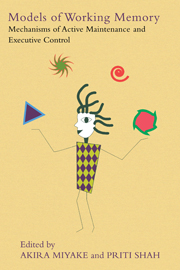Book contents
- Frontmatter
- Contents
- List of Contributors
- Dedication
- Preface
- Ode on Working Memory
- Acknowledgments
- 1 Models of Working Memory: An Introduction
- 2 Working Memory: The Multiple-Component Model
- 3 An Embedded-Processes Model of Working Memory
- 4 Individual Differences in Working Memory Capacity and What They Tell Us About Controlled Attention, General Fluid Intelligence, and Functions of the Prefrontal Cortex
- 5 Modeling Working Memory in a Unified Architecture: An ACT-R Perspective
- 6 Insights into Working Memory from the Perspective of the EPIC Architecture for Modeling Skilled Perceptual-Motor and Cognitive Human Performance
- 7 The Soar Cognitive Architecture and Human Working Memory
- 8 Long-Term Working Memory as an Alternative to Capacity Models of Working Memory in Everyday Skilled Performance
- 9 Interacting Cognitive Subsystems: Modeling Working Memory Phenomena Within a Multiprocessor Architecture
- 10 Working Memory in a Multilevel Hybrid Connectionist Control Architecture (CAP2)
- 11 A Biologically Based Computational Model of Working Memory
- 12 Models of Working Memory: Eight Questions and Some General Issues
- 13 Toward Unified Theories of Working Memory: Emerging General Consensus, Unresolved Theoretical Issues, and Future Research Directions
- Name Index
- Subject Index
6 - Insights into Working Memory from the Perspective of the EPIC Architecture for Modeling Skilled Perceptual-Motor and Cognitive Human Performance
Published online by Cambridge University Press: 05 June 2012
- Frontmatter
- Contents
- List of Contributors
- Dedication
- Preface
- Ode on Working Memory
- Acknowledgments
- 1 Models of Working Memory: An Introduction
- 2 Working Memory: The Multiple-Component Model
- 3 An Embedded-Processes Model of Working Memory
- 4 Individual Differences in Working Memory Capacity and What They Tell Us About Controlled Attention, General Fluid Intelligence, and Functions of the Prefrontal Cortex
- 5 Modeling Working Memory in a Unified Architecture: An ACT-R Perspective
- 6 Insights into Working Memory from the Perspective of the EPIC Architecture for Modeling Skilled Perceptual-Motor and Cognitive Human Performance
- 7 The Soar Cognitive Architecture and Human Working Memory
- 8 Long-Term Working Memory as an Alternative to Capacity Models of Working Memory in Everyday Skilled Performance
- 9 Interacting Cognitive Subsystems: Modeling Working Memory Phenomena Within a Multiprocessor Architecture
- 10 Working Memory in a Multilevel Hybrid Connectionist Control Architecture (CAP2)
- 11 A Biologically Based Computational Model of Working Memory
- 12 Models of Working Memory: Eight Questions and Some General Issues
- 13 Toward Unified Theories of Working Memory: Emerging General Consensus, Unresolved Theoretical Issues, and Future Research Directions
- Name Index
- Subject Index
Summary
FIVE CENTRAL FEATURES OF THE THEORY
Computational modeling of human perceptual-motor and cognitive performance based on a comprehensive detailed information-processing architecture leads to new insights about the components of working memory. To illustrate how such insights can be achieved, a precise production- system model that uses verbal working memory for performing a serial memory span task through a strategic phonological loop has been constructed with the Executive-Process/Interactive-Control (EPIC) architecture of Kieras and Meyer. EPIC is characterized by five central features that may be compared and contrasted with those of other theoretical frameworks in this volume. These features include:
(1) Formal implementation with multiple component mechanisms for perceptual, cognitive, and motor information processing (cf. Barnard, Chapter 9; Lovett, Reder, & Lebiere, Chapter 5; Young & Lewis, Chapter 7; Schneider, Chapter 10).
(2) Representation of procedural knowledge in terms of a production system whose condition-action rules are all applied simultaneously and repeatedly during the cyclic operation of a central cognitive processor (cf. Lovett et al., Chapter 5; Young & Lewis, Chapter 7; O'Reilly, Braver, & Cohen, Chapter 11).
(3) Executive control procedures that schedule task activities efficiently and coordinate the use of limited-capacity peripheral perceptualmotor processors (cf. Baddeley & Logie, Chapter 2; Cowan, Chapter 3; Engle, Tuholski, & Kane, Chapter 4).
(4) Explicit simulations that accurately account for quantitative behavioral data (cf. Lovett et al., Chapter 5; Young & Lewis, Chapter 7).
[…]
- Type
- Chapter
- Information
- Models of Working MemoryMechanisms of Active Maintenance and Executive Control, pp. 183 - 223Publisher: Cambridge University PressPrint publication year: 1999
- 29
- Cited by



